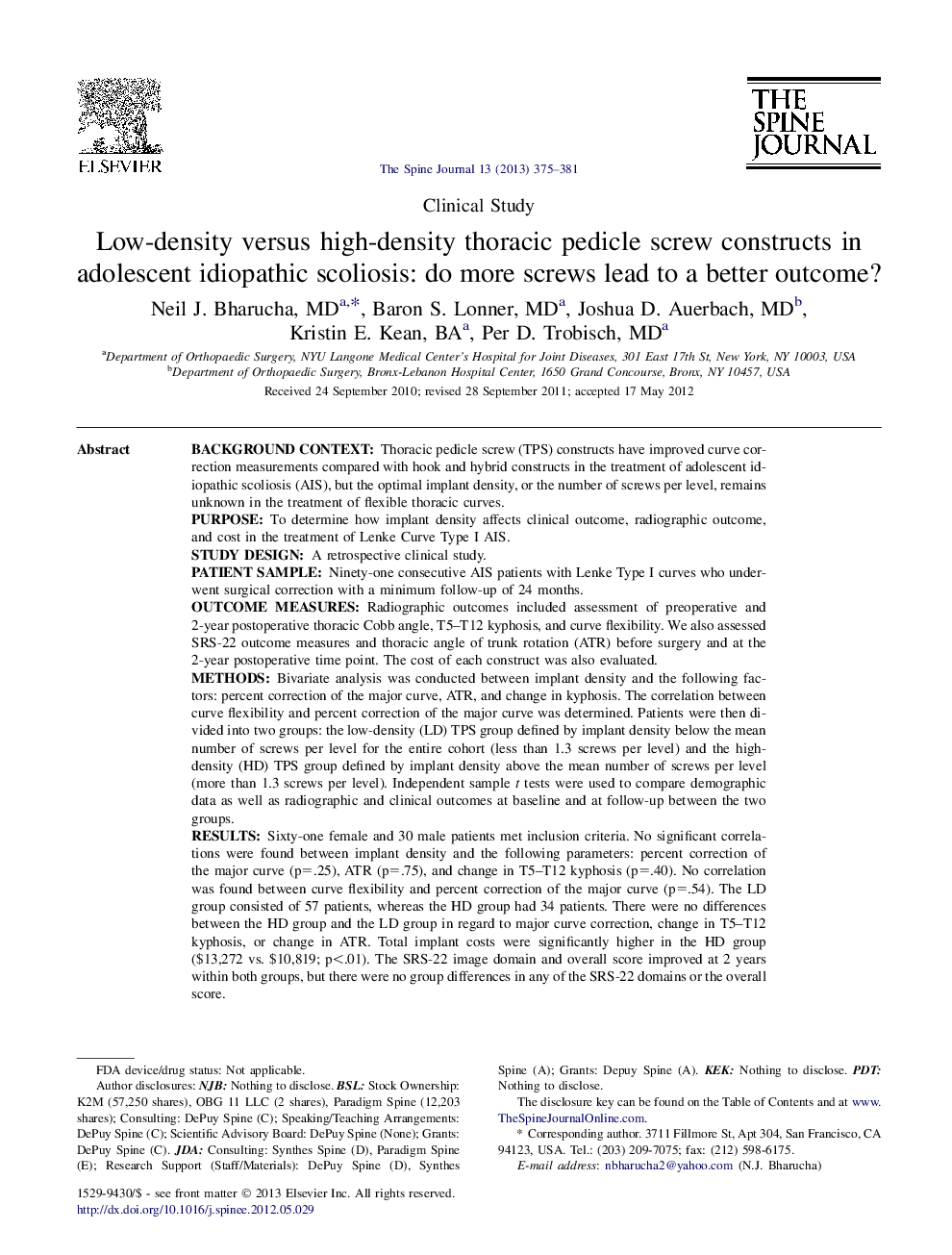| کد مقاله | کد نشریه | سال انتشار | مقاله انگلیسی | نسخه تمام متن |
|---|---|---|---|---|
| 6212660 | 1268587 | 2013 | 7 صفحه PDF | دانلود رایگان |
Background contextThoracic pedicle screw (TPS) constructs have improved curve correction measurements compared with hook and hybrid constructs in the treatment of adolescent idiopathic scoliosis (AIS), but the optimal implant density, or the number of screws per level, remains unknown in the treatment of flexible thoracic curves.PurposeTo determine how implant density affects clinical outcome, radiographic outcome, and cost in the treatment of Lenke Curve Type I AIS.Study designA retrospective clinical study.Patient sampleNinety-one consecutive AIS patients with Lenke Type I curves who underwent surgical correction with a minimum follow-up of 24 months.Outcome measuresRadiographic outcomes included assessment of preoperative and 2-year postoperative thoracic Cobb angle, T5-T12 kyphosis, and curve flexibility. We also assessed SRS-22 outcome measures and thoracic angle of trunk rotation (ATR) before surgery and at the 2-year postoperative time point. The cost of each construct was also evaluated.MethodsBivariate analysis was conducted between implant density and the following factors: percent correction of the major curve, ATR, and change in kyphosis. The correlation between curve flexibility and percent correction of the major curve was determined. Patients were then divided into two groups: the low-density (LD) TPS group defined by implant density below the mean number of screws per level for the entire cohort (less than 1.3 screws per level) and the high-density (HD) TPS group defined by implant density above the mean number of screws per level (more than 1.3 screws per level). Independent sample t tests were used to compare demographic data as well as radiographic and clinical outcomes at baseline and at follow-up between the two groups.ResultsSixty-one female and 30 male patients met inclusion criteria. No significant correlations were found between implant density and the following parameters: percent correction of the major curve (p=.25), ATR (p=.75), and change in T5-T12 kyphosis (p=.40). No correlation was found between curve flexibility and percent correction of the major curve (p=.54). The LD group consisted of 57 patients, whereas the HD group had 34 patients. There were no differences between the HD group and the LD group in regard to major curve correction, change in T5-T12 kyphosis, or change in ATR. Total implant costs were significantly higher in the HD group ($13,272 vs. $10,819; p<.01). The SRS-22 image domain and overall score improved at 2 years within both groups, but there were no group differences in any of the SRS-22 domains or the overall score.ConclusionsWe identified no clinical, radiographic, perioperative, or complication-related advantage of constructs with higher TPS implant density in this patient cohort with flexible idiopathic scoliosis. Cost was significantly higher with HD constructs in comparison with LD constructs. Optimal implant density chosen by the surgeon should rely on a number of factors including curve magnitude and rigidity, bone density, and desired correction.
Journal: The Spine Journal - Volume 13, Issue 4, April 2013, Pages 375-381
